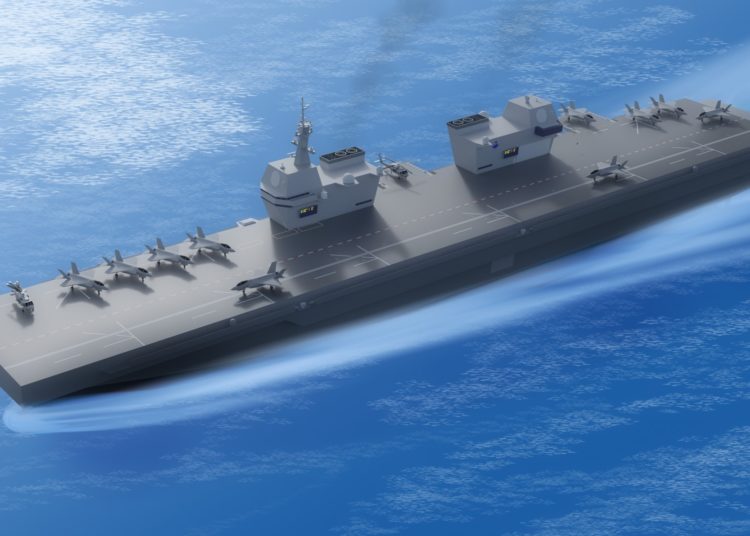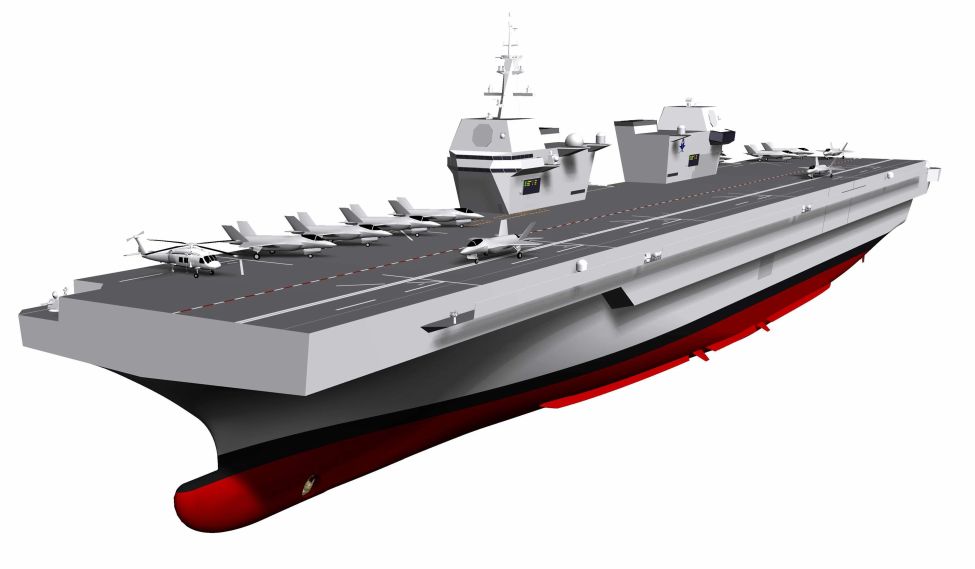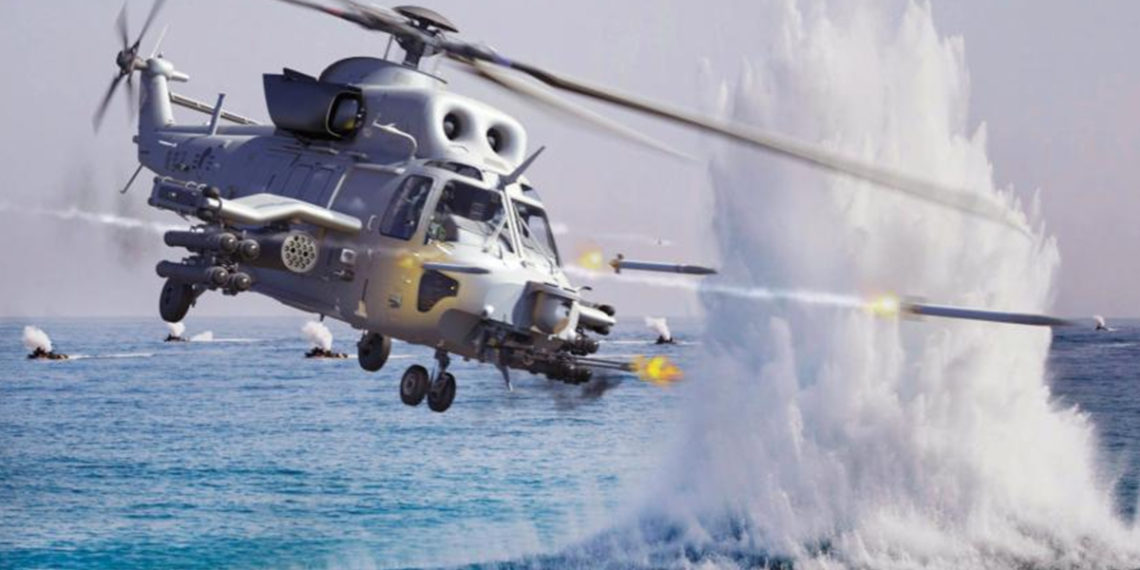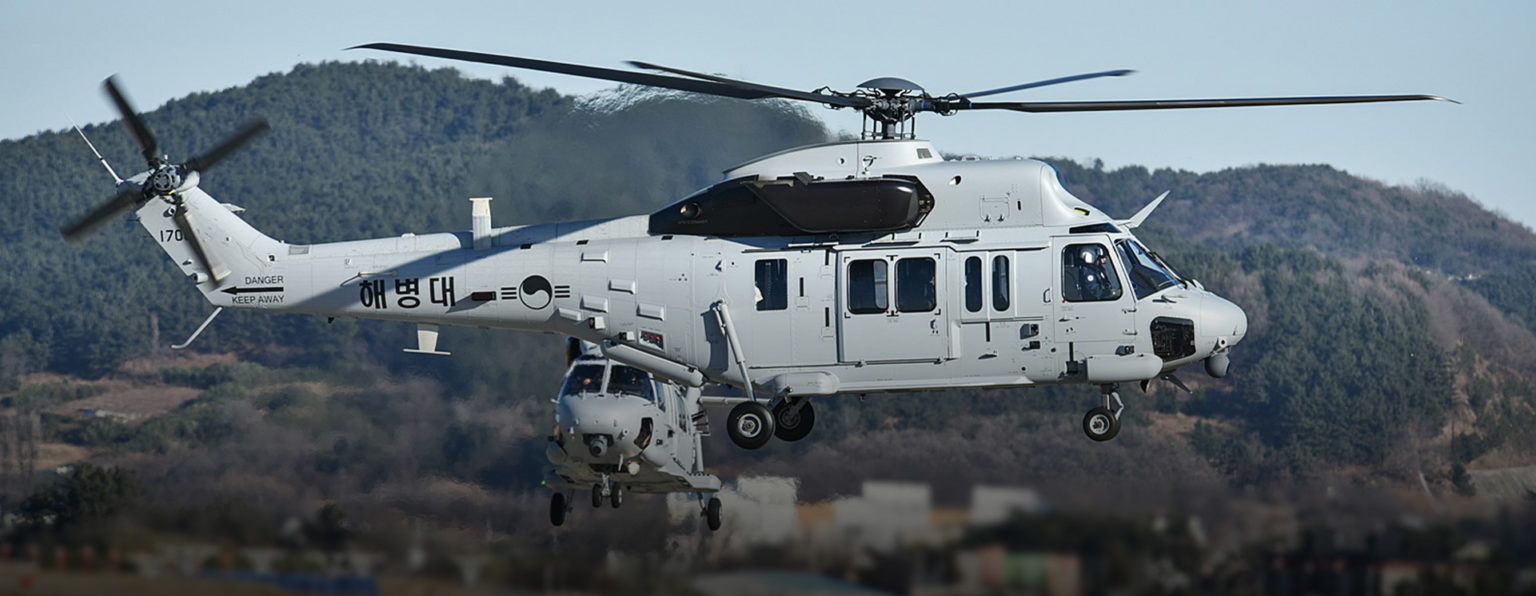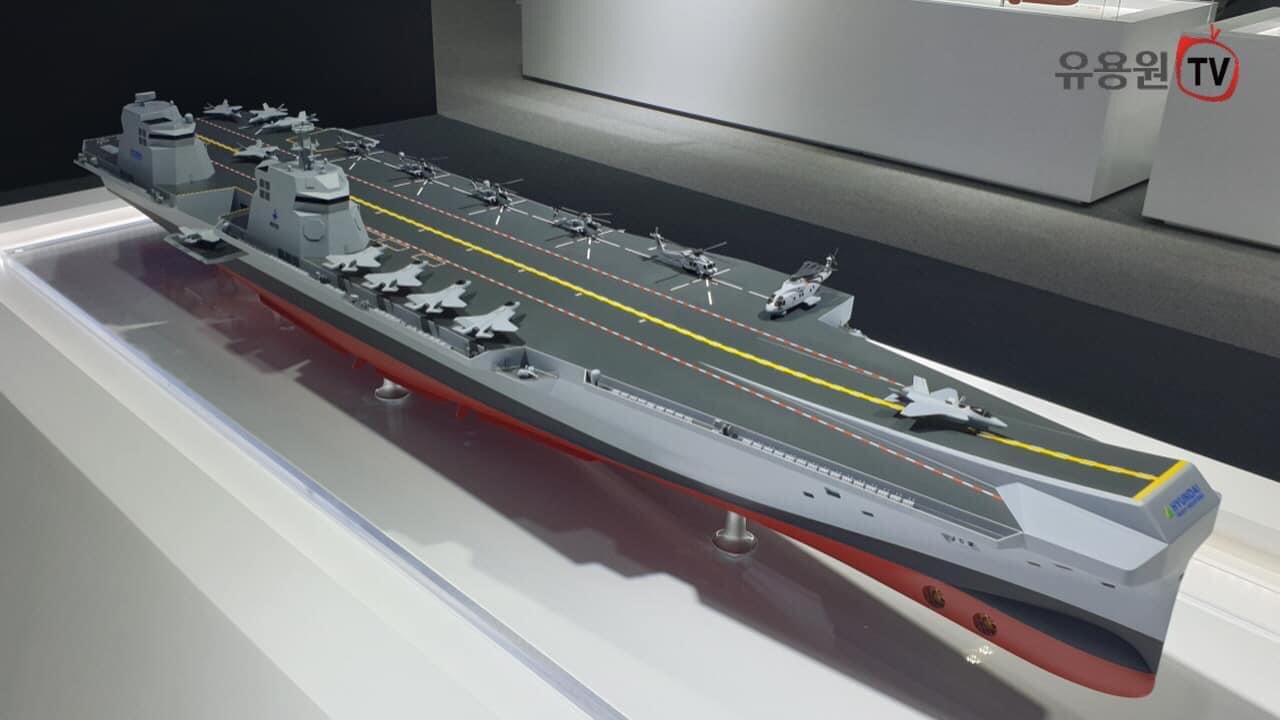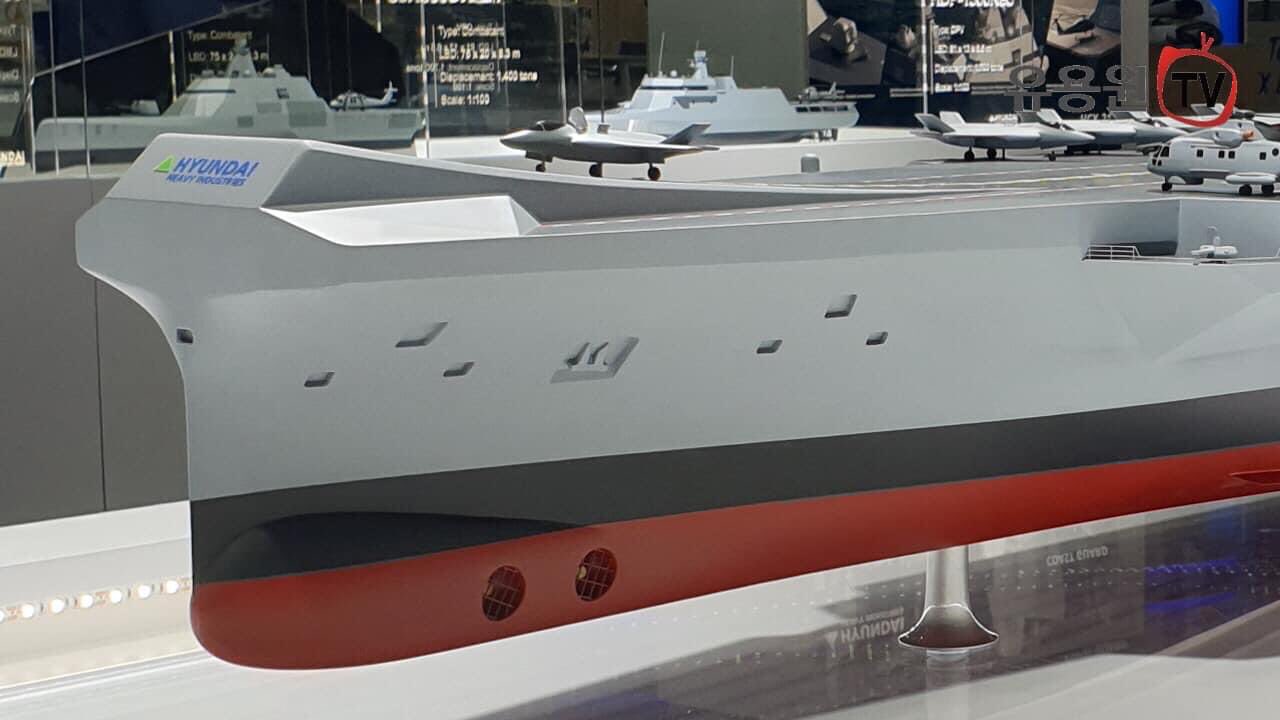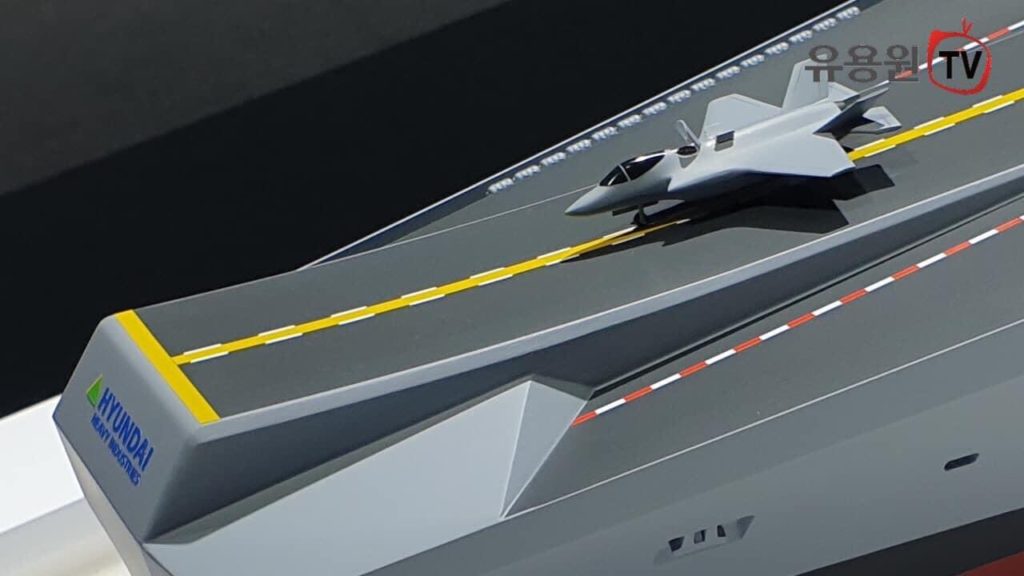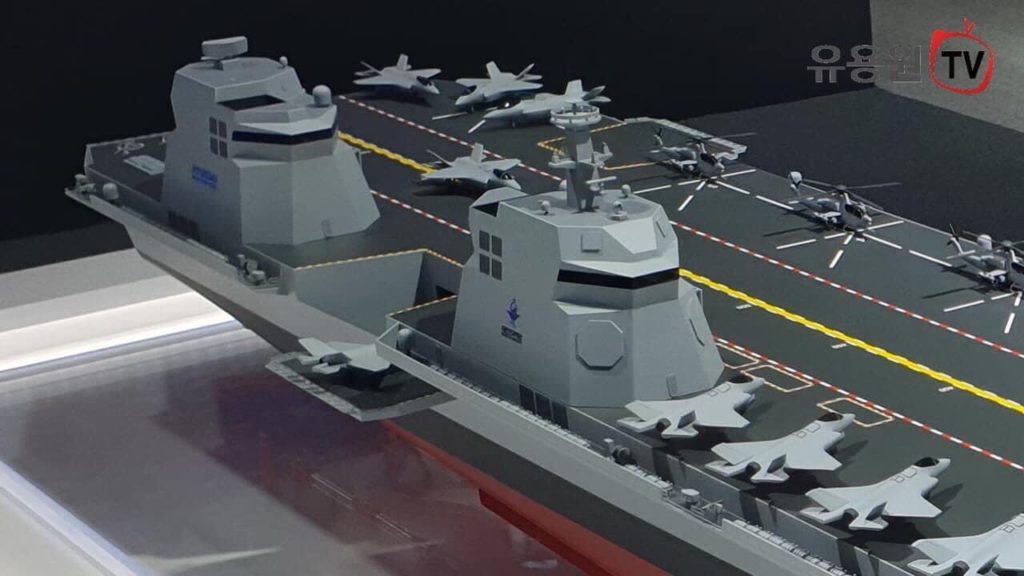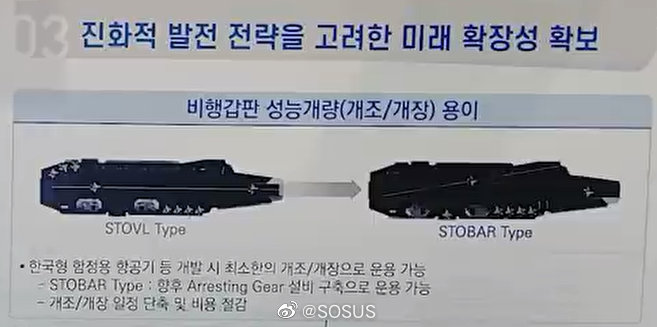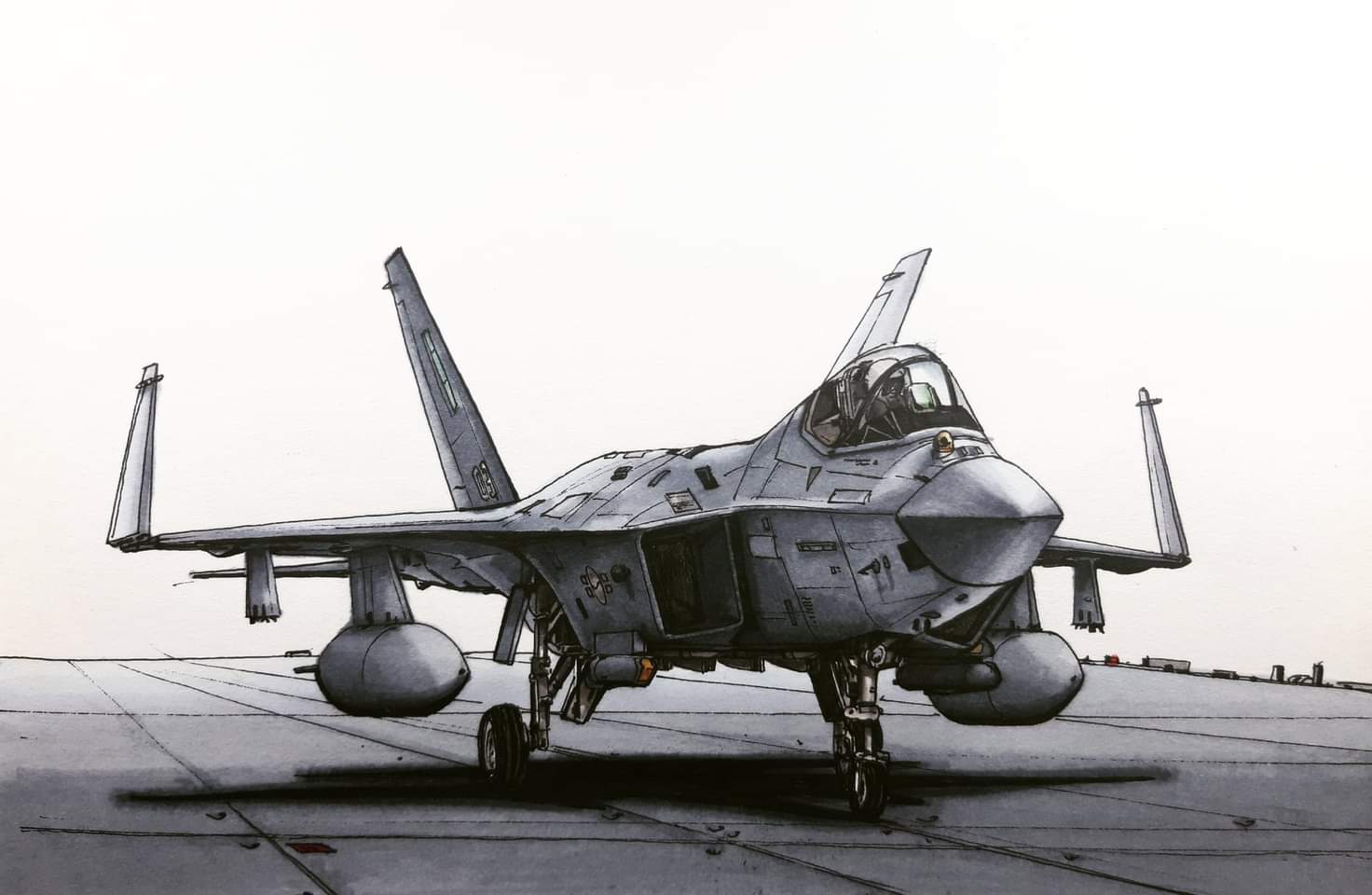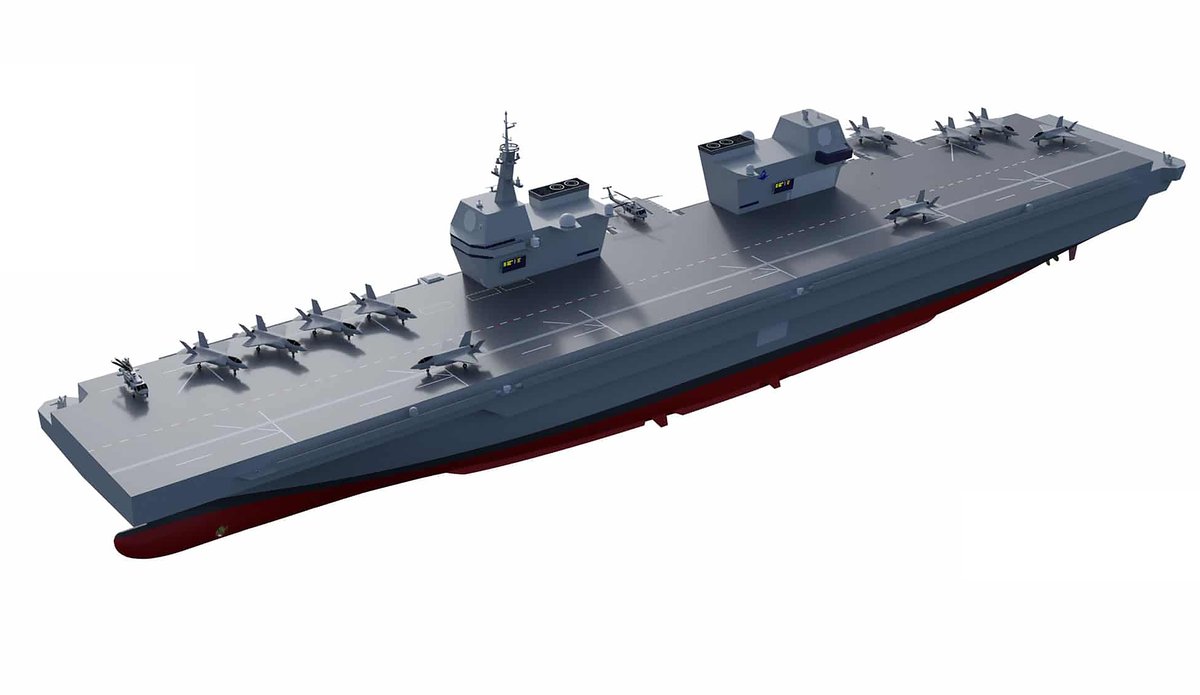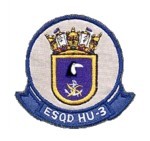LPX-II: Coreia do Sul oficializa seu programa de Porta-Aviões
por Guilherme Wiltgen | 03/01/2021 - 11:51
No dia 30 de dezembro, a Coreia do Sul informou que os detalhes do porta-aviões LPX-II foram finalizados e o orçamento necessário está oficialmente no Plano de Defesa de Meio Termo de 2020-2024.
Isto significa que, após cerca um ano de planejamento preliminar e debate, o programa está oficialmente em andamento, e espera-se que o porta-aviões entre em serviço em 2030.
O LPX-II irá priorizar as operações aéreas em detrimento das operações anfíbias. O design do navio não contempla uma “Ski-Jump”, terá duas ilhas e não terá doca alagável.
A aeronave primária será o F-35B Lightning II e os seu sensores e armamentos serão todos nacionais. A ROK Navy planeja utilizar os mesmo radar AESA que está sendo desenvolvido para o KDDX para equipar o LPX-II.
Em termos de parceiros estrangeiros, especula-se que tanto o governo dos EUA quanto do Reino Unido, bem como as empresas defesas, também estão envolvidas. Os EUA irão transferir a tecnologia para o convoo reforçado, como parte da compra F-35B, enquanto que o Reino Unido tem prestado consultoria técnica e doutrinária.
Artigo: https://www.defesaaereanaval.com.br/nav ... rta-avioes
Marinha da Coreia do Sul
Moderador: Conselho de Moderação
- JavaLindo66
- Intermediário

- Mensagens: 330
- Registrado em: Ter Nov 26, 2019 9:07 pm
- Localização: Salvador
- Agradeceu: 206 vezes
- Agradeceram: 114 vezes
Re: Marinha da Coreia do Sul
- JavaLindo66
- Intermediário

- Mensagens: 330
- Registrado em: Ter Nov 26, 2019 9:07 pm
- Localização: Salvador
- Agradeceu: 206 vezes
- Agradeceram: 114 vezes
Re: Marinha da Coreia do Sul
2033? Será que sai primeiro que nosso SubNuc?South Korea to begin work on light aircraft carrier in 2022
by Gabriel Dominguez & Dae Young Kim | 24 February 2021
South Korea’s Defense Acquisition Programme Administration (DAPA) announced on 23 February that work on the Republic of Korea Navy’s (RoKN’s) future next-generation light aircraft carrier is slated to officially start in 2022 and be completed by 2033.
Citing a decision made the previous day by the country’s Defense Project Promotion Committee, DAPA said that about KRW2.3 trillion (USD2.07 billion) has been tentatively earmarked for the project, which was previously known as LPX-II but has now renamed CVX.
The RoKN unveiled in January a revised conceptual design for its future light aircraft carrier featuring a twin-island arrangement. Work on the carrier project is now set to officially begin in 2022 and be completed by 2033, according to DAPA. (RoKN)
The agency pointed out that the total project cost “will be reviewed/confirmed through a feasibility study” set to be conducted by the Ministry of Economy and Finance.
DAPA said the CVX project is aimed securing the country’s the first light aircraft carrier to “suppress provocations in disputed waters” and to quickly respond to “various security threats” through the use of short take-off and vertical landing (STOVL) aircraft.
The latest developments come after the RoKN unveiled a revised conceptual design of the carrier on 3 January. The latest design, which confirms that the vessel will not have a ski-jump, features a twin-island arrangement.
The computer-generated imagery (CGI) also appeared to confirm that the service plans to operate Lockheed Martin F-35B Joint Strike Fighters from the vessel. Naval helicopters, somewhat similar in appearance to the Sikorsky/Lockheed Martin MH-60R Seahawk, can also be seen on the carrier.
The RoKN pointed out, however, that the latest conceptual design can be further revised during the basic and detailed designed stages.
Artigo completo: https://www.janes.com/defence-news/news ... er-in-2022
- Túlio
- Site Admin

- Mensagens: 61504
- Registrado em: Sáb Jul 02, 2005 9:23 pm
- Localização: Tramandaí, RS, Brasil
- Agradeceu: 6321 vezes
- Agradeceram: 6670 vezes
- Contato:
Re: Marinha da Coreia do Sul
Sei lá eu, cupincha, mas pelo menos o nosso SNA (se sair) poderá operar de maneira independente, basta a MB mandar; já esse bicho aí vai precisar de permissão da China, Japão, Rússia e até Coréia do Norte se quiser fazer-se ao mar:


“Look at these people. Wandering around with absolutely no idea what's about to happen.”
P. Sullivan (Margin Call, 2011)
P. Sullivan (Margin Call, 2011)
- JavaLindo66
- Intermediário

- Mensagens: 330
- Registrado em: Ter Nov 26, 2019 9:07 pm
- Localização: Salvador
- Agradeceu: 206 vezes
- Agradeceram: 114 vezes
Re: Marinha da Coreia do Sul
Coreia do Sul decide prosseguir com desenvolvimento de helicóptero para fuzileiros navais
Por Fernando Valduga - 27/04/2021
A Administração do Programa de Aquisição de Defesa da Coreia do Sul (DAPA) disse hoje que quer desenvolver um helicóptero de ataque nacional para operação com seu Corpo de Fuzileiros Navais, baseado no MUH-1 Marineon.
A agência de aquisição de armas reservou US$ 1,44 bilhão para o projeto. O comitê de promoção do projeto de defesa, presidido pelo ministro da Defesa, Suh Wook, aprovou o projeto, que deve começar para valer no próximo ano e ser concluído por volta de 2031, informou hoje a agência de notícias Yonhap.
A nova plataforma será baseada no MUH-1 Marineon, a variante da Marinha do helicóptero KUH-1 Surion do país, de acordo com as autoridades.
O KUH-1 Surion foi desenvolvido pela Korea Aerospace Industries (KAI) e pela Eurocopter. Eles podem ser usados ??em uma variedade de aplicações, incluindo assalto a tropas, busca e resgate, transporte tático, ligação e evacuação médica. Pode acomodar um piloto, co-piloto, dois artilheiros e nove soldados
O helicóptero possui um sistema de navegação inercial, sistema de posicionamento global, um sistema de controle automático de voo, radar infravermelho voltado para a frente e um mapa digital.
O Surion também está equipado com sistema de monitoramento de saúde e uso, sistema modular de armas, dispensador de contra-medidas, contra-medidas infravermelhas, contra-medidas eletrônicas, receptor de alerta radar, coletivo hands-on e stick e sistema embarcado de geração de gás inerte.
O helicóptero pode ser equipado com seis mísseis ar-ar BGM-71 lançados por tubo de rastreamento óptico (TOW) ou quatro pods lançadores de foguetes.
Artigo: https://www.cavok.com.br/coreia-do-sul- ... ros-navais
- JavaLindo66
- Intermediário

- Mensagens: 330
- Registrado em: Ter Nov 26, 2019 9:07 pm
- Localização: Salvador
- Agradeceu: 206 vezes
- Agradeceram: 114 vezes
Re: Marinha da Coreia do Sul
South Korea’s New CVX Aircraft Carrier Project: An Overview
by Juho Lee | 27 May 2021
Here is everything you need to know about the CVX project ahead of MADEX 2021
The booth for CV eXperimental (CVX), the project name for South Korea’s first aircraft carrier, at the MADEX International Maritime Defense Industry Exhibition this year will constitute 30% of the entire display area, according to Yonhap News. This decision is not just for pomp and circumstance. The Ministry of National Defense (MND) faces an uphill battle to convince the National Assembly and the public of the usefulness of CVX. Its request of ₩101 billion ($90 million) in funds for research into CVX for the 2021 fiscal year was denied by the National Defense Committee which only allocated ₩1 billion ($890,000) for this purpose.
The resistance may be hard to understand at first. Many nations consider aircraft carriers to be a point of pride, a symbol of their great power status. South Korea, however, faces very immediate security challenges, and many question whether an aircraft carrier, let alone a light aircraft carrier, can meet those challenges.
CVX history, dimensions, and capabilities
Concept image of ROK Navy’s future LPX-II displayed on HHI stand during MADEX 2019
The CVX program evolved from the Landing Platform eXperimental (LPX) program which produced the largest ships operated by the Republic of Korea Navy (ROKN) so far, the Dokdo class amphibious assault ships. Preliminary plans, dubbed LPX-II, envisioned an amphibious assault ship like vessel that would also be capable of operating fighter aircraft. However, in Aug. 2020, the ROKN officially announced plans to acquire a fully-fledged aircraft carrier and the term CVX was introduced in Feb. 2021. The ROKN hopes CVX will be ready for operations by 2033.
The CVX is expected to cost ₩2.3 trillion ($2 billion) to construct and around ₩50 billion ($45 million) per year to maintain. It will be 265 m in length, 43 m in width and have a light and maximum displacement of around 30,000 tons and 40,000 tons respectively. The ship will be capable of operating 16 F-35B fighters as well as eight helicopters. It will also feature a high degree of automation and have a complement of 440 crew, excluding the air element. The carrier will have two islands, similar to the Royal Navy’s Queen Elizabeth (QE) class, but lacks a ski-jump.
CVX will be equipped with the AESA radar being designed by Hanwha for the “integrated mast” on the KDDX destroyer. The S band radar will have a range of 300 km for long range detection of aircraft, while the X band radar will be used for short range detection. The carrier will also feature LIG Nex1’s torpedo acoustic countermeasure, Haegung (K-SAAM) surface to air missile system, and close in weapon systems (CIWS) for point defence.
ROK Navy’s vision for CVX
ROK Navy artist impression show the future CSG around CVX
The CVX will be the flagship of the ROKN and will be the centerpiece of its blue-water fleet. The ROKN expects the ship to protect South Korea’s lines of communications, provide deterrence against North Korea, and aid humanitarian relief operations. The CVX is also a response to Korea’s great power neighbors; both China and Japan plan on acquiring multiple aircraft carriers. It is hoped that CVX will deter both powers.
Moreover, the CVX will also be capable of serving as a landing helicopter dock, deploying forces ashore during landing operations. It will augment South Korea’s amphibious assault fleet which consists of two Dokdo class amphibious assault ships, four Go Jun Bong class LSTs, and four Cheon Wang Bong class LSTs.
Some even speculate that CVX will serve as a stepping stone for a larger carrier in the future. It is hoped that once the ROKN has gained enough operational experience from operating the CVX, it will become capable of operating supercarriers.
Lastly, proponents of the program claim that CVX will provide South Korea with a conventional second strike capability. They claim that Korean airfields are vulnerable to a first strike by North Korean forces; for them the nightmare scenario is a barrage of missiles crippling the entire Republic of Korea Air Force (ROKAF) before its fighters can even take-off. Operating the F-35B from CVX would preclude this possibility.
Criticism
No defence procurement program has generated as much controversy domestically in recent years as the CVX program. Dissenting voices from the National Assembly, academia, and the rest of civil society at large have lambasted the program as a waste of resources.
Does South Korea need an aircraft carrier?
The first group of critics cast doubt on whether South Korea needs an aircraft carrier at all. Hong Joon-pyo, a veteran member of the National Assembly who is currently on the National Defence Committee, is a vocal proponent of the first view. He is quoted as saying “all a physically small country, like ours, needs is land based airfields. Our money would be better spent on building nuclear submarines instead,” to the National Defence Committee last November.
Many in academia support this claim. The crux of the argument is that an aircraft carrier is “overkill” when it comes to dealing with North Korea, but not sufficient to counter the fleets of neighboring great powers. Critics claim that the threat of a neutralizing first strike on South Korean airfields by North Korea is exaggerated and that a single aircraft carrier would not be enough to deter China or Japan which plans on building multiple aircraft carriers. Operating nuclear-powered attack submarines (SSNs), on the other hand, would allow constant shadowing of North Korean ballistic missile submarines (SSB) currently in development, as well as providing a strong undersea deterrent against aggression from other neighbors.
Critics also claim that investing in submarines is the more rational choice given the geography of the Korean peninsula which is surrounded by thousands of small islands. According to them, South Korea does not have any overseas territories and, thus, does not need to project power far from its shores.
Some worried that the acquisition of CVX and the 20 F-35Bs that would operate from the ship would interfere with ROKAF’s acquisition of F-35As. The ROKAF had purchased 40 F-35As and planned to procure an additional 20 aircraft of the same type.
These fears were attenuated when the MND announced that ROKAF plans would not be affected. According to Joongang Ilbo, the ROKAF will operate both the F-35A and F-35B for a total of 80 aircraft, similar to how the Royal Air Force operates aircraft from Royal Navy carriers. This view was echoed by a ROKN spokesperson on April 21. However, critics still point out that the procurement of the second batch of F-35As may be delayed due to the priority given to F-35B acquisition.
CATOBAR vs STOVL?
The second group of critics acknowledges the utility of aircraft carriers, but demands the procurement of one capable of catapult assisted take-off but arrested recovery (CATOBAR). They claim that the current design, which is tailored for short take-off and vertical landing (STOVL), limits the CVX’s capabilities.
To begin with, the F-35B cannot carry the 2000 lb joint direct attack ammunition internally due to its smaller internal weapons bay. This means the ship will not be able to target hardened North Korean bunkers and missile silos if conflict breaks out. A CATOBAR carrier would allow for the operation of the F-35C which has a greater internal payload and greater range.
A STOVL carrier would also not be able to operate fixed-wing early warning aircraft, such as the E-2D Hawkeye. This worries critics who claim that better situational awareness will be paramount if South Korean forces are to overcome the numerical superiority of neighbouring great powers in a potential conflict. They claim that without it, CVX would be a veritable sitting duck against larger and more numerous Chinese and Japanese carriers. The situation is made worse by the fact that the ROKN does not yet even plan to operate early warning helicopters from its CVX.
Lastly, operating the F-35B on a light aircraft carrier is very inefficient. The F-35B needs to jettison much of its payload before it can land vertically. To counter this, the Royal Navy developed the shipborne rolling vertical landing (SRVL) technique which allows the F-35B to land with its payload. However, SRVL technique needs an 80 meters long runway to be performed safely. Critics claim this will make it difficult for the CVX to simultaneously launch and recover aircraft, lowering sortie rates significantly.
Despite this backlash, the MND remains determined to carry on with the project. It has launched a fierce hearts and minds campaign to convince the public of the utility of CVX. However, many still remain doubtful. Whether the MND will alter CVX’s design to appease critics remains to be seen.
British involvement in CVX ?
HMS Prince of Wales and HMS Queen Elizabeth pictured at sea for the first time. Royal Navy picture.
According to reports by British media, Babcok Marine, BAE systems, and Thales have already begun to reach out to South Korean companies regarding cooperation on CVX. Moreover, some speculate HMS Queen Elizabeth’s port visit to Busan in the second half of 2021 will serve as an overture from Britain regarding cooperation on CVX, according to Yonhap news. “There is a possibility Britain will share knowledge and operational experience regarding carrier operations when its fleet visits Busan,” a South Korean MND spokesperson said on April 27.
One possible area of cooperation is heat-resistant materials, which will be especially important for operating the F-35B. The ROKN has little expertise in this regard given that neither of its Dokdo class ships are capable of operating fixed-wing aircraft.
In addition to this, some hope that British experience with early-warning helicopters will help the ROKN develop its own operational doctrine that utilizes maritime early-warning aircraft. Critics still point out, however, that early-warning helicopters are less effective then fixed wing aircraft.
Korean Aerospace Industries (KAI) KF-21 for the CVX?
KF-X full scale model at Seoul Airshow 2019
KAI revealed that it is aiming to start development of a navalized variant of the KF-21 in 2033 as part of the KF-21 block 2 development program on April 2. The MND is also keeping all options on the table for now. “There is a possibility that a domestically designed fighter will operate from the light aircraft carrier if it can meet required operational capabilities, and if the necessary technology and production facilities are secured before the aircraft carrier is completed,” said a ministry spokesperson on April 21.
At this point, it is unclear what a navalized KF-21 will look like and how it will operate. Some speculate that KAI is developing a STOVL variant of the KF-21. This would require a major redesign of the airframe and is likely to be extremely expensive. Others think that KAI is aiming to design a short take-off but arrested recovery (STOBAR) variant. This would require fewer changes to the airframe; resistance to saltwater, stronger landing gear, a landing hook, and larger wings are some new features that may have to be added.
However, the carrier in its current configuration is not suitable for STOBAR operations. According to Konkuk University Professor, Lee Jaewoo, the flight deck will have to be lengthened by around 20 m for STOBAR operations to become feasible. Moreover, the ship will have to be capable of maintaining a speed of 30 knots, much higher than the maximum speed of the Dokdo class which is 23 knots.
In addition to this, doubts linger as to whether these plans will be affordable. “A large budget will be required if a new navalized domestic fighter is to be developed,” said an MND spokesperson on April 21. The ROKN is already cash strapped as it pursues other expensive programs, such as the 6,000 ton arsenal ship, and may not be able to secure funds for such an ambitious change.
Artigo: https://www.navalnews.com/event-news/ma ... -overview/
- JavaLindo66
- Intermediário

- Mensagens: 330
- Registrado em: Ter Nov 26, 2019 9:07 pm
- Localização: Salvador
- Agradeceu: 206 vezes
- Agradeceram: 114 vezes
Re: Marinha da Coreia do Sul
MADEX 2021: Hyundai revela novo design de porta-aviões CVX
Por Alexandre Galante | 10 de junho de 2021
Um novo projeto para o CVX, o programa de porta-aviões leves da Coreia do Sul, foi revelado pela Hyundai Heavy Industries (HHI) no MADEX 2021.
O novo design é significativamente diferente do design anterior da própria HHI e do atual projeto da Daewoo Shipbuilding & Marine Engineering (DSME).
O navio tem um deslocamento vazio de 30.000 toneladas. Apesar disso, o navio tem 60 metros de boca e 270 metros de comprimento e um convoo de 260 metros.
Como o projeto anterior, o navio é capaz de transportar 16 a 20 caças F-35B, bem como helicópteros.
O navio possui ilhas gêmeas e dois elevadores de aeronaves em cada lado do convoo. A primeira ilha será responsável pelas operações gerais, enquanto a segunda ilha realizará as funções de controle de voo. Além disso, o design em forma de X das novas ilhas oferece vantagens únicas, como furtividade e melhor visibilidade para os controladores das operações aéreas.
O projeto também também prevê a possibilidade de mudança da configuração STOBAR (short take off but arrested recovery), com a instalação de um convés em ângulo e cabos de retenção para pouso de aeronaves que usem gancho de parada.
A configuração STOBAR poderá operar uma versão naval do caça stealth sul-coreano KF-21.
Concepção artística de uma versão naval do caça sul-coreano KF-21Artigo: https://www.naval.com.br/blog/2021/06/1 ... vioes-cvx/
- JavaLindo66
- Intermediário

- Mensagens: 330
- Registrado em: Ter Nov 26, 2019 9:07 pm
- Localização: Salvador
- Agradeceu: 206 vezes
- Agradeceram: 114 vezes
Re: Marinha da Coreia do Sul
Uma coisa que achei interessante nesse modelo é que eles já pensaram nos drones.


- JavaLindo66
- Intermediário

- Mensagens: 330
- Registrado em: Ter Nov 26, 2019 9:07 pm
- Localização: Salvador
- Agradeceu: 206 vezes
- Agradeceram: 114 vezes
Re: Marinha da Coreia do Sul
Fincantieri apoia Daewoo no projeto do novo porta-aviões sul-coreano
Por Redação Forças de Defesa | 10 de junho de 2021
Trieste, 10 de junho de 2021 – Durante a MADEX (International Maritime Defense Industry Exhibition) 2021, uma das principais exposições navais na região da Ásia-Pacífico, a Fincantieri assinou um contrato com a Daewoo Shipbuilding & Marine Engineering (DSME) para apoiar o Projeto Conceitual da nova classe de porta-aviões “CVX” para a Marinha da República da Coreia (Coréia do Sul).
O programa referente à unidade de primeira classe prevê a licitação do Projeto Básico a partir do segundo semestre de 2021, enquanto o projeto de detalhamento e construção terá início nos anos seguintes.
A assinatura foi realizada entre Jung Woo Sung, vice-presidente da divisão de marketing naval e especial de navios da DSME, e Marco Cerruti, gerente regional de vendas da Fincantieri, na presença de Federico Failla, embaixador italiano em Seul, vice-almirante Dario Giacomin, vice-general de defesa Secretário – Subdiretor Nacional de Armamento e Contra-Almirante Antonio Natale, Assessor do Estado-Maior da Marinha Italiana.
A Fincantieri assessorará a DSME com base na experiência adquirida com a construção do LHD (Landing Helicopter Dock) “Trieste”, que será entregue no próximo ano à Marinha Italiana. Com o acordo, a Fincantieri reforça sua presença no país, estreitando ainda mais o relacionamento com a República da Coreia. Na verdade, através de sua subsidiária Seastema, o Grupo está cooperando na construção de oito novas fragatas da classe “Daegu” (FFX-II) para a Marinha nacional, fornecendo SEASNavy, um sistema de gerenciamento de plataforma integrado (IPMS) inovador.
A assinatura deste contrato marca um passo importante para o Grupo no estabelecimento de uma cooperação estratégica com a DSME. Em um país com alta capacidade de construção naval, tal cooperação pode fornecer suprimentos significativos para esta unidade e pode ser estendida a outros produtos ou setores no futuro.
O projeto da unidade “Trieste” representa o que há de mais moderno para essa classe de navios, além de ser um produto comprovado que atende plenamente aos requisitos operacionais da Marinha da Coreia. Com o LHD, a Fincantieri provou sua capacidade de projetar e construir unidades altamente inovadoras que representam uma referência no cenário internacional.
Artigo: https://www.naval.com.br/blog/2021/06/1 ... l-coreano/
Imagens: https://www.navalnews.com/naval-news/20 ... er-design/
- JavaLindo66
- Intermediário

- Mensagens: 330
- Registrado em: Ter Nov 26, 2019 9:07 pm
- Localização: Salvador
- Agradeceu: 206 vezes
- Agradeceram: 114 vezes
- FCarvalho
- Sênior

- Mensagens: 37943
- Registrado em: Sex Mai 02, 2003 6:55 pm
- Localização: Manaus
- Agradeceu: 5735 vezes
- Agradeceram: 3272 vezes
Re: Marinha da Coreia do Sul
Resta saber se este navio da Daewoo terá rampa ou não. Em caso negativo, isto afeta negativamente todo o projeto ao limitar as operações dos F-35B que venham a ser operados.
Carpe Diem
- cabeça de martelo
- Sênior

- Mensagens: 39540
- Registrado em: Sex Out 21, 2005 10:45 am
- Localização: Portugal
- Agradeceu: 1137 vezes
- Agradeceram: 2858 vezes
Re: Marinha da Coreia do Sul
Fincantieri to support Daewoo in the design of the New Korean Aircraft Carriers
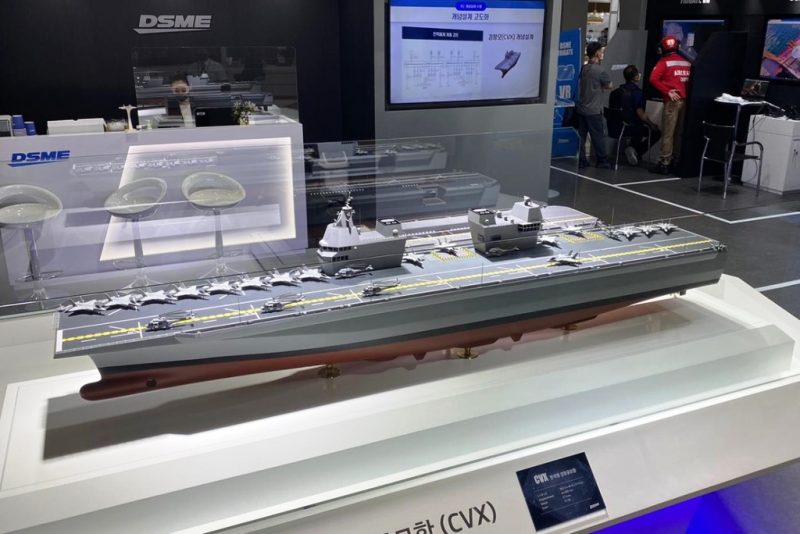
Trieste, June 10, 2021 – During MADEX (International Maritime Defense Industry Exhibition) 2021, one of the main naval exhibitions in the Asia Pacific area, Fincantieri has signed a contract with Daewoo Shipbuilding & Marine Engineering (DSME) to support the Conceptual Design of the new class of aircraft carriers “CVX” for the Navy of the Republic of Korea (South Korea).
The program relating to the first-in-class unit envisages the tender for the Basic Design starting from the second half of 2021, whereas the detail design and construction will begin in the following years.
The signing took place between Jung Woo Sung, Vice President Naval & Special Ship Marketing Division of DSME, and Marco Cerruti, Regional Sales Manager of Fincantieri, in the presence of Federico Failla, Italian Ambassador in Seoul, Vice Admiral Dario Giacomin, Deputy Defense General Secretary – Deputy National Armament Director, and Rear Admiral Antonio Natale, Advisor of the Chief of Staff of the Italian Navy.
Fincantieri will advise DSME based on the expertise gained with the construction of the LHD (Landing Helicopter Dock) “Trieste”, which will be delivered next year to the Italian Navy. With this agreement, Fincantieri strengthens its presence in the country, further boosting the relationship with the Republic of Korea. In fact, through its subsidiary Seastema, the Group is cooperating in the construction of eight new Daegu class frigates (FFX-II) for the national Navy, providing SEASNavy, an innovative integrated platform management system (IPMS).
The signing of this contract marks an important step for the Group in establishing a strategic cooperation with DSME. In a country with high naval shipbuilding capabilities, such cooperation might provide significant supplies for this unit and it might be extended to other products or sectors in the future. The “Trieste” unit’s design represents the state-of-the-art for this class of ships, in addition to being a well-proven product fully meeting the operational requirements of the Korean Navy. With the LHD, Fincantieri has proven its ability to design and build highly innovative units which represent a benchmark in the international scenario.
 https://www.edrmagazine.eu/fincantieri- ... t-carriers
https://www.edrmagazine.eu/fincantieri- ... t-carriers

Trieste, June 10, 2021 – During MADEX (International Maritime Defense Industry Exhibition) 2021, one of the main naval exhibitions in the Asia Pacific area, Fincantieri has signed a contract with Daewoo Shipbuilding & Marine Engineering (DSME) to support the Conceptual Design of the new class of aircraft carriers “CVX” for the Navy of the Republic of Korea (South Korea).
The program relating to the first-in-class unit envisages the tender for the Basic Design starting from the second half of 2021, whereas the detail design and construction will begin in the following years.
The signing took place between Jung Woo Sung, Vice President Naval & Special Ship Marketing Division of DSME, and Marco Cerruti, Regional Sales Manager of Fincantieri, in the presence of Federico Failla, Italian Ambassador in Seoul, Vice Admiral Dario Giacomin, Deputy Defense General Secretary – Deputy National Armament Director, and Rear Admiral Antonio Natale, Advisor of the Chief of Staff of the Italian Navy.
Fincantieri will advise DSME based on the expertise gained with the construction of the LHD (Landing Helicopter Dock) “Trieste”, which will be delivered next year to the Italian Navy. With this agreement, Fincantieri strengthens its presence in the country, further boosting the relationship with the Republic of Korea. In fact, through its subsidiary Seastema, the Group is cooperating in the construction of eight new Daegu class frigates (FFX-II) for the national Navy, providing SEASNavy, an innovative integrated platform management system (IPMS).
The signing of this contract marks an important step for the Group in establishing a strategic cooperation with DSME. In a country with high naval shipbuilding capabilities, such cooperation might provide significant supplies for this unit and it might be extended to other products or sectors in the future. The “Trieste” unit’s design represents the state-of-the-art for this class of ships, in addition to being a well-proven product fully meeting the operational requirements of the Korean Navy. With the LHD, Fincantieri has proven its ability to design and build highly innovative units which represent a benchmark in the international scenario.
- akivrx78
- Sênior

- Mensagens: 6534
- Registrado em: Dom Fev 08, 2009 8:16 am
- Agradeceu: 115 vezes
- Agradeceram: 344 vezes
Re: Marinha da Coreia do Sul
Antes disso eles tem que decidir onde sera feita a manutenção de seus F-35 ainda hoje eles não sabem o que vão fazer.
Se vai mandar para o Eua ou Austrália ou vão pedir para o Japão, a Mitsubishi pode recusar o cliente por causa da desapropriação de bens da empresa na Coreia do Sul.
Conhecendo como eles operam os equipamentos se compra 40 para manter uns 10 com capacidade de operação, vão culpar os fornecedores por não facilitar a manutenção.
Eles compraram 40 F-35 e as versões compradas já necessitam de upgrades o governo da CS esta reclamando dizendo que ainda nem recebeu a encomenda completa e já vai ter de gastar com upgrades, a LM esta pedindo cerca de Us$7 milhões por unidade para fazer o upgrade...
A Coreia do Sul acabou de receber os Global Hawk dos 4 que eles compraram 2 unidades não voam por falta de manutenção. Pasme eles nem entraram em operação ainda se pretende introduzir eles no final do ano, na fase de treinamento já ficou sem peças de reposição.
- FCarvalho
- Sênior

- Mensagens: 37943
- Registrado em: Sex Mai 02, 2003 6:55 pm
- Localização: Manaus
- Agradeceu: 5735 vezes
- Agradeceram: 3272 vezes
Re: Marinha da Coreia do Sul
Parece que no campo militar os sul coreanos não repetem, ou não conseguem repetir, o mesmo desempenho que suas empresas tem mundo afora.
O que será que anda faltando? Ou em excesso?
O que será que anda faltando? Ou em excesso?
Carpe Diem
- akivrx78
- Sênior

- Mensagens: 6534
- Registrado em: Dom Fev 08, 2009 8:16 am
- Agradeceu: 115 vezes
- Agradeceram: 344 vezes
Re: Marinha da Coreia do Sul
Os políticos são cobrados pelos gastos, se por exemplo um F-35 via FMS custa US$100 milhões, e com o pacote de peças de manutenção vai sair por US$170 milhões a unidade como justificar o preço mais alto aos contribuintes?
Os militares sempre querem o que exite de mais moderno no mercado, os políticos compram mas na hora de operar... se inicia a caça as bruxas para ver quem fez o planejamento errado.
Eles não fazem planejamento a longo prazo sempre se tenta dar o passo maior que a perna, as empresas deles tem sucesso quando consegue negociar a compra de tecnologia no exterior, ai eles desenvolvem um produto utilizando como base a tecnologia comprada, mas quando vão desenvolver uma coisa do zero...
O Eua não proibiu a manutenção dos F35 em solo coreano, eles precisam apenas abrir os bolsos e pagar os custos de um centro de manutenção, porem os gastos seriam altos inviabilizando o investimento os japoneses construíram um centro para eles mas vai fornecer manutenção aos jatos americanos por isto o investimento tem retorno no caso coreano os americanos não mantêm aeronaves na Coreia do Sul ou seja não existe demanda para justificar a construção de um centro de manutenção somente para os F35 coreanos.
- akivrx78
- Sênior

- Mensagens: 6534
- Registrado em: Dom Fev 08, 2009 8:16 am
- Agradeceu: 115 vezes
- Agradeceram: 344 vezes
Re: Marinha da Coreia do Sul
Em janeiro deste ano um sub classe 214 coreano emitiu alerta de socorro o sistema de propulsão e emersão apresentou problemas e teve de ser rebocado de volta ao porto, o motivo do problema é desconhecido. (se desconfia ser falta de manutenção) o problema ocorreu na superfície se estivesse submerso sabe la o que poderia ter acontecido.
A lista de problemas no 214 da Coreia do Sul é enorme.
Hélice do sistema de propulsão com problemas de fabricação, as hélices ficaram todas trincadas, o problema foi descoberto somente apos já ter sido construído 4 unidades.
Depois ocorreu o problema nos parafusos utilizados na parte interna para unir os blocos na vela do sub, primeiro culparam o fornecedor dos parafusos, depois culparam os alemães, ai os alemães descobriram porque os parafusos quebravam, os coreanos alteram o projeto original, as junções do casco foram construídas de outra forma, todos os subs tiveram de receber chapas para reforçar as juntas dos blocos...
Depois apareceu o problema de ruídos emitidos pelo sistema de propulsão, os ruídos eram 4 vezes acima do normal, demorou 2 anos para descobrir a causa do problema se foi resolvido ninguém sabe.
Depois teve o problema das baterias com defeito....o fabricante local disse na tv que a nova bateria foi testada 24 horas e não apresentou problema! A marinha aceitou a nova bateria testada 24 horas...
Depois apareceu o problema no AIP que deveria funcionar por 2 semanas, mas somente aguenta 24 horas funcionando...o sistema apresentou problemas 93 vezes!
Depois apareceu a noticia de que as portas dos tubos do torpedos estavam enferrujados e não podiam disparar torpedos.
Depois teve o problema do sistema de geração de oxigênio que estava gerando gases tóxicos....
Estes problemas aparecem nas tvs coreanas com tantos problemas, ninguém quer servir nos submarinos menos de 40% das vagas são preenchidas.
Mesmo sem resolver todos os problemas de fabricação dos 214 eles construíram uma nova classe Dosan e mesmo sem a primeira unidade estar finalizada já iniciaram a construção da terceira unidade para quem nunca projetou um submarino do zero e apresentou vários problemas em fabricar um sub sob licença me parece ser loucura o que eles estão fazendo.
